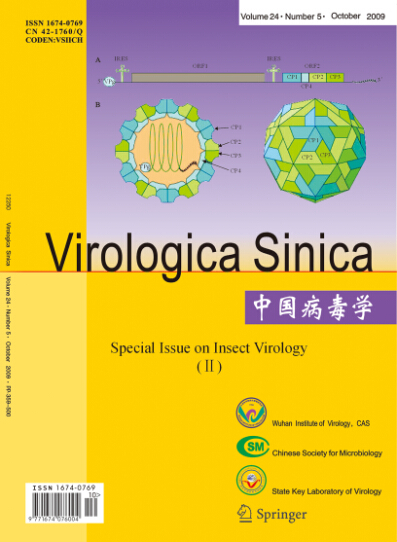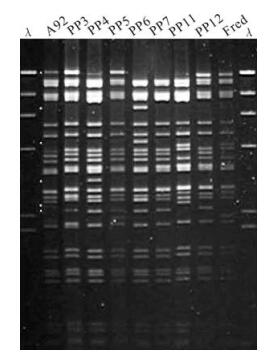-
Adams J R, McClintock J T. 1991. Nuclear polyhedrosis viruses in insects. In: Atlas of Invertebrate Viruses (Adams J R, Bonami J R. ed. ), Boca Raton: CRC Press, FL, USA. p89-204.
-
Blissard G W, Rohrmann G F. 1990. Baculovirus diversity and molecular biology. Ann Rev Entomol, 35: 127-155.
doi: 10.1146/annurev.en.35.010190.001015
-
Brown D A, Evans H F, Allen C J, et al. 1981. Biological and biochemical investigations of five European isolates of Mamestra brassicae nuclear polyhedrosis virus. Arch Virol, 69, 209-217.
doi: 10.1007/BF01317336
-
Bull J C, Godfray H C, O'Reilly D R. 2001. Persistence of an occlusion-negative recombinant nucleopolyhedrovirus in Trichoplusia ni indicates high multiplicity of cellular infection. Appl Environ Microbiol, 67: 5204-5209.
doi: 10.1128/AEM.67.11.5204-5209.2001
-
Chen X, IJkel W F, Tarchini R, et al. 2001. The sequence of the Helicoverpa armigera single nucleocapsid nucleopolyhedrovirus genome. J Gen Virol, 82: 241-257.
doi: 10.1099/0022-1317-82-1-241
-
Cooper D, Cory J S, Myers J H. 2003a. Hierarchical spatial structure of genetically variable nucleopolyhe-droviruses infecting cyclic populations of western tent caterpillars. Mol Ecol, 12: 881-890.
doi: 10.1046/j.1365-294X.2003.01785.x
-
Cooper D, Cory J S, Theilmann D A, et al. 2003b. Nucleopolyhedroviruses of forest and western tent caterpillars: cross-infectivity and evidence for activation of latent virus in high-density field populations. Ecol Entomol, 28: 41-50.
doi: 10.1046/j.1365-2311.2003.00474.x
-
Cory J S, Hails R S, Sait S M. 1997. Baculovirus ecology. In: The Baculoviruses(Miller L K. ed. ), New York: Plenum Press. p301-339.
-
Cory J S, Green B M, Paul R K, et al. 2005. Genotypic and phenotypic diversity of a baculovirus population within an individual insect host. J Invert Pathol, 89: 101-111.
doi: 10.1016/j.jip.2005.03.008
-
Crook N E. 1986. Restriction enzyme analysis of granulosis viruses isolated from Artogeia rapae and Pieris brassicae. J Gen Virol, 67: 781-787.
doi: 10.1099/0022-1317-67-4-781
-
Crook N E, Spencer R A, Payne C C, et al. 1985. Variation in Cydia pomonella granulosis virus isolates and physical maps of the DNA from three variants. J Gen Virol, 66: 2423-2430.
doi: 10.1099/0022-1317-66-11-2423
-
Crozier G, Ribeiro H C T. 1992. Recombination as a possible major cause of genetic heterogeneity in Anticarsia gemmatalis nuclear polyhedrosis virus wild populations. Virus Res, 26: 183-196.
doi: 10.1016/0168-1702(92)90012-X
-
Eberle K E, Sayed S, Rezapanah M, et al, 2009. Diversity and evolution of the Cydia pomonella granulovirus. J Gen Virol, 90: 662-671.
doi: 10.1099/vir.0.006999-0
-
Ebling P M, Kaupp W J. 1995. Differentiation and comparative activity of six isolates of nuclear polyhedrosis virus from the forest tent caterpillar, Malacosoma disstria, Hubner. J Invert Pathol, 66: 198-200.
doi: 10.1006/jipa.1995.1084
-
Erlandson M A. 1990. Biological and biochemical comparison of Mamestra configurata and Mamestra brassicae nuclear polyhedrosis virus isolates pathogenic for the bertha armyworm, Mamestra configurata (Lepidoptera: Noctuidae). J Invert Pathol, 56: 47-56.
doi: 10.1016/0022-2011(90)90143-T
-
Erlandson M A, Baldwin D, Havereon M, et al. 2006. Isolation and characterization of plaque purified strains of Malacosoma disstria nucleopolyhedrovirus. Can J Microbiol, 52: 266-271.
doi: 10.1139/W05-116
-
Fan Q, Li S, Wang L, et al. 2007. The genome sequence of the mulitnucleocapsid nucleopolyhedrovirus of the Chinese oak silkworm Antherea pernyi. Virology, 366: 304-315.
doi: 10.1016/j.virol.2007.04.027
-
Figueiredo E, Muñzo D, Murillo R, et al. 2009. Diversity of Iberian nucleopolyhedrovirus wild-type isolates infecting Helicoverpa armigera (Lepidoptera: Noctuidae). Biological Control, 50, 43-49.
doi: 10.1016/j.biocontrol.2009.02.005
-
Goto C, Minobe Y, Iizuka T. 1992. Restriction analysis and mapping of the genomes of granulosis viruses isolated from Xestia c-nigrum and five other noctuid species. J GenVirol, 73: 1491-1497.
-
Graham R I, Tyne W I, Possee R D, et al.2004. Genetically variable nucleopolyhedroviruses isolated from spatially separate populations of the winter moth Operophtera brumata (Lepidoptera: Geometridae) in Orkney. J Invert Pathol, 87: 29-38.
doi: 10.1016/j.jip.2004.06.002
-
Harrison R L, Puttler B, Popham H J R. 2008. Genomic sequence analysis of a fast-killing isolate of Spodoptera frugiperda multiple nucleopolyhedrovirus. J Gen Virol, 89: 775-790.
doi: 10.1099/vir.0.83566-0
-
Hitchman R B, Hodgson D J, King L A, et al. 2007. Host mediated selection of pathogen genotypes as a mechanism for the maintenance of baculovirus diversity in the field. J Invert Pathol, 94, 153-162.
doi: 10.1016/j.jip.2006.10.002
-
Hodgson D J, Vanbergen A J, Hartley S E, et al. 2002. Differential selection of baculovirus genotypes mediated by different species of host food plant. Ecol Lett, 5: 512-518.
doi: 10.1046/j.1461-0248.2002.00338.x
-
Hodgson D J, Vanbergen A J, Watt A D, et al. 2001. Phenotypic variation between naturally co-existing genotypes of a Lepidopteran baculovirus. Evol Ecol Res, 3: 687-701.
-
Jehle J A, Fritsch E, Huber J, et al. 2003. Intra-specific and inter-specific recombination of tortricid-specific granuloviruses during co-infection in insect larvae. Arch Virol, 148: 1317-1333.
-
Jehle J A, Blissard G W, Bonning B C, et al. 2006. On theclassification and nomenclature of baculoviruses: a proposal for revision. Arch Virol, 151, 1257-1266.
doi: 10.1007/s00705-006-0763-6
-
Jia F, Xu J, Nie Y C, et al. 2003. Comparison of Heliothis armigera NPV VHA273 wild isolate with its clone. Viroligica Sinica, 18: 241-245.
-
Kamiya K, Zhu J, Murata M, et al. 2004. Cloning and comparative characterization of three distinct nucleopoly-hedroviruses isolated from the common cutworm, Spodop-tera litura (Lepidoptera: Noctuidae) in Japan. Biol Contr, 31: 38-48.
doi: 10.1016/j.biocontrol.2004.04.003
-
Keddie A B, Erlandson M A. 1995. Characterization of a nuclear polyhedrosis virus from the forest tent caterpillar, Malacosoma disstria. J Invert Pathol, 65: 43-47.
doi: 10.1006/jipa.1995.1006
-
Knell J D, Summers M D. 1981. Investigation of genetic heterogeneity in wild isolates of Spodoptera frugiperda nuclear polyhedrosis virus by restriction endonuclease analysis of plaque-purified mutants. Virology, 112: 190-197.
doi: 10.1016/0042-6822(81)90624-3
-
Kolodny-Hirsch D M, Van Beek N A M. 1997. Selection of a morphological variant of Autographa californica nuclear polyhedrosis virus with increased virulence following serial passage in Plutella xylostella. J Invert Pathol, 69: 205-211.
doi: 10.1006/jipa.1997.4659
-
Lee H H, Miller L K. 1978. Isolation of genotypic variants of Autographa californica nuclear polyhedrosis virus. J Virol, 27: 754-767.
-
Li L, Donly C, Li Q, et al. 2002. Identification and genomic analysis of a second species of nucleopoly-hedrovirus isolated from Mamestra configurata. Virology, 297: 226-244.
doi: 10.1006/viro.2002.1411
-
Li L, Li Q, Willis L G, et al. 2005. Complete Comparative Genomic Analysis of Two Field Isolates of Mamestra configurata Nucleopolyhedrovirus-A. J Gen Virol, 86: 91-105
doi: 10.1099/vir.0.80488-0
-
Li Q, Donly C, Li L, et al. 2002. Sequence and organization of the Mamestra configurata nucleopoly-hedrovirus genome. Virology, 294, 106-121.
doi: 10.1006/viro.2001.1313
-
López Ferber M, Argaud O, Croizier L, et al. 2001. Diversity, distribution, and mobility of bro gene sequences in Bombyx mori nucleopolyhedrovirus. Virus Genes, 22: 247-254.
doi: 10.1023/A:1011193603093
-
Lynn D E, Shapiro M, Dougherty E M. 1993. Selection and screening of clonal isolates of the Abington strain of gypsy moth nuclear polyhedrosis virus. J Invert Pathol, 62: 191-195.
doi: 10.1006/jipa.1993.1095
-
Maeda S, Kamita S G, Kondo A. 1993. Host range expansion of Autographa califomica nuclear polyhedrosis virus (NPV) following recombination of a 0.6 kbp DNA fragment originating from Bombyx mori NPV. J Virol, 67: 6234-6238.
-
McIntosh A H, Rice W C, Ignoffo C M. 1987. Genotypic variants in wild-type populations of baculovirus. In Biotechnology in Invertebrate Pathology and Cell Culture (Maramorosch K. ed. ), New York: Academic Press, p305-325.
-
Muñoz D, Castillejo J I, Caballero P. 1998. Naturally occurring deletion mutants are parasitic genotypes in a wild-type nucleopolyhedrovirus population of Spodoptera exigua. Appl Environ Microbiol, 64: 4372-4377.
-
Muñoz D, Murillo R, Krell P J, et al. 1999. Four genotypic variants of a Spodoptera exigua Nucleopoly-hedrovirus (Se-SP2) are distinguished by a hypervariable genomic region. Virus Res, 59: 61-74.
doi: 10.1016/S0168-1702(98)00125-7
-
Muñoz D, Caballero P. 2000. Persistence and effects of parasitic genotypes in a mixed population of the Spodop-tera exigua nucleopolyhedrovirus. Biol Contr, 19: 259-264.
doi: 10.1006/bcon.2000.0864
-
Nie Z M, Zhang Z F, Wang D, et al. 2007. Complete sequence and organization of Anteraea pernyi nucleopoly-hedrovirus, a dr-rich baculovirus. BMC Genomics, 8: 248
doi: 10.1186/1471-2164-8-248
-
Ogembo J G, Chaeychomsri S, Kamiya K, et al. 2007. Cloning and comparative characterization of nucleopoly-hedroviruses isolated from African bollworm, Helicoverpa armigera, (Lepidoptera: Noctudiae) in different geographic regions. J Insect Biotechnol Sericol, 76: 39-49.
-
Pijlman G P, van den Born E, Martens D E, et al. 2001. Autographa californica baculoviruses with large genomic deletions are rapidly generated in infected insect cells. Virology 283:132-138.
doi: 10.1006/viro.2001.0854
-
Shapiro D I, Fuxa J R, Braymer HD, et al. 1991. DNA restriction polymorphism in wild isolates of Spodoptera frugiperda nuclear polyhedrosis virus. J Invert Pathol, 58: 96-105.
doi: 10.1016/0022-2011(91)90167-O
-
Simón O, Williams T, López-Ferber M, et al. 2004. Genetic structure of a Spodoptera frugiperda nucleopoly-hedrovirus population: High prevalence of deletion genotypes. Appl Environ Microbiol, 70: 5579-5588.
doi: 10.1128/AEM.70.9.5579-5588.2004
-
Simón O, Williams T, López-Ferber M, et al. 2005. Functional importance of deletion mutant genotypes in an insect nucleopolyhedrovirus population. Appl Environ Microbiol, 71: 4254-4262.
doi: 10.1128/AEM.71.8.4254-4262.2005
-
Smith I R L, Crook N E. 1988. In vivo isolation of baculovirus genotypes. Virology, 166: 240-244.
doi: 10.1016/0042-6822(88)90165-1
-
Smith G E, Summers M D. 1979. Restriction Maps of Five Autographa californica MNPV Variants, Trichoplusia ni MNPVand Galleria mellonella MNPV DNAs with restriction endonucleases SmaI, KpnI, BamHI, SacI, XhoI, and EcoRI. J Virol, 30: 828-838.
-
Stiles B, Himmerich S. 1998. Autographa californica NPV isolates: Restriction endonuclease analysis and comparative biological activity. J Invert Pathol, 72, 174-177.
doi: 10.1006/jipa.1998.4758
-
Theilmann D A, Blissard G W, Bonning B, et al. 2005. Family Baculoviridae. In: Virus Taxonomy, Eighth Report of the International Committee on Virus Taxonomy (Fauquet C M, Mayo M A, Maniloff J, et al. ed. ), San Diego: Elsevier Press, p177-185.
-
van Oers M M, Vlak J M. 2007. Baculovirus Genomics. Current Drug Targets, 8: 1051-1068.
doi: 10.2174/138945007782151333
-
Vlak J M, Gröner A. 1980. Identification of two nuclear polyhedrosis viruses from the cabbage moth, Mamestra brassicae (Lepidoptera: Noctuidae). J Invert Pathol, 35, 269-278.
doi: 10.1016/0022-2011(80)90162-7
-
Vickers J M, Cory J S, Entwistle P F. 1991. DNA characterization of eight geographic isolates of granulosis virus from the potato tuber moth (Phthorimaea operculella) (Lepidoptera, Gelechiidae). J Invert Pathol, 57, 334-342.
doi: 10.1016/0022-2011(91)90137-F
-
Wolff J L C, Vaicente F H, Martins R, et al. 2008. Analysis of the genome of Spodoptera frugiperda nucleopoly-hedrovirus (SfMNPV-19) and of the high genomic heterogeneity in Group Ⅱ nucleopolyhedroviruses. J Gen Virol, 89, 1202-1211.
doi: 10.1099/vir.0.83581-0
-
Yanase Y, Hashimoto Y, Kawarabata T. 2000. Identification of insertion and deletion genes in Autographa californica nucleopolyhedrovirus variants isolated from Galleria mellonella, Spodoptera exigua, Spodoptera litura and Xestia c-nigrum. Virus Genes, 21: 167-177.
doi: 10.1023/A:1008183329145
-
Zhang C X, Ma X C, Guo Z J. 2005. Comparison of the complete genome sequence between C1 and G4 isolates of the Helicoverpa armigera single nucleocapsid nucleopoly-hedrovirus.Virology, 333 (1):190-199.
doi: 10.1016/j.virol.2004.12.028












